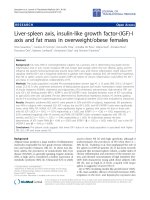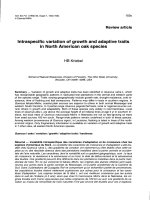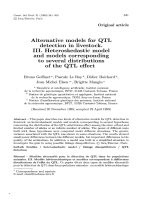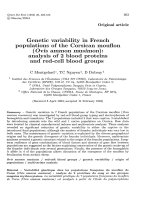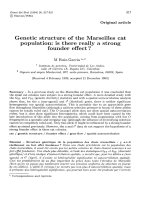Báo cáo sinh học: "Genetic variation of traits measured in several environments. I. Estimation and testing of homogeneous genetic and intra-class correlations between environments" ppt
Bạn đang xem bản rút gọn của tài liệu. Xem và tải ngay bản đầy đủ của tài liệu tại đây (644.16 KB, 13 trang )
Original
article
Genetic
variation
of
traits
measured
in
several
environments.
I.
Estimation
and
testing
of
homogeneous
genetic
and
intra-class
correlations
between
environments
C
Robert,
JL
Foulley
V
Ducrocq
Institut
national
de
la
recherche
agronomique,
station
de
génétique
quantitative
et
appliquee,
centre
de
recherche
de
Jouy-en-Josas,
78352
Jouy-en-Josas
cede!,
France
(Received
23
March
1994;
accepted
26
September
1994)
Summary -
Estimation
of
between
family
(or
genotype)
components
of
(co)variance
among
environments,
testing
of
homogeneity
of
genetic
correlations
between
environ-
ments,
and
testing
of
homogeneity
of
both
genetic
and
intra-class
correlations
between
environments
are
investigated.
The
testing
procedures
are
based
on
the
ratio
of
maxi-
mized
log-restricted
likelihoods
for
the
reduced
(under
each
hypothesis
of
homogeneity)
and
saturated
models,
respectively.
An
expectation-maximization
(EM)
iterative
algo-
rithm
is
proposed
for
calculating
restricted
maximum
likelihood
(REML)
estimates
of
the
residual
and
between-family
components
of
(co)variance.
The
EM
formulae
are
applied
to
the
multiple
trait
linear
model
for
the
saturated
model
and
to
the
univariate
linear
model
for
the
reduced
models.
The
EM
algorithm
guarantees
that
(co)variance
estimates
remain
within
the
parameter
space.
The
procedures
presented
in this
paper
are
illustrated
with
the
analysis
of
5
vegetative
and
reproductive
traits
recorded
in
an
experiment
on
20
full-sib
families
of
black
medic
(Medicago
lupulina
L)
tested
in
3
environments.
heteroskedasticity
/
genetic
correlation
/
intra-class
correlation
/
expectation-
maximization
/
restricted
maximum
likelihood
Résumé -
Variation
génétique
de
caractères
mesurés
dans
plusieurs
milieux.
I.
Esti-
mation
et
test
d’homogénéité
des
corrélations
génétiques
et
intra-classe
entre
milieux.
Cet
article
étudie
les
problèmes
d’estimation
des
composantes
familiales
de
(co)variance
entre
milieux
et
les
problèmes
de
test
d’homogénéité,
soit
des
corrélations
génétiques
en-
tre
milieux
seules,
soit
des
corrélations
génétiques
et
des
corrélations
intra-classe
entre
milieux.
Les
procédures
de
test
reposent
sur
le
rapport
de
vraisemblances
restreintes
maxi-
misées
sous
les
modèles
réduits
(les
différentes
hypothèses
d’homogénéité)
et
le
modèle
saturé.
Un
algorithme
itératif
d’espérance-maximisation
(EM)
est
proposé
pour
calculer
les
estimations
du
maximum
de
vraisemblance
restreinte
(REML)
des
composantes
résiduelles
et
familiales
de
variance-covariance.
Les
formules
EM
s’appliquent
au
modèle
multica-
ractère
pour
le
modèle
saturé
et
à
des
modèles
linéaires
univariés
pour
les
modèles
réduits.
Les
formules
EM
garantissent
l’appartenance
des
composantes
de
(co)variance
estimées
à
l’espace
des
paramètres.
Les
procédures
présentées
dans
cet
article
sont
illustrées
par
l’analyse
de
5
caractères
végétatifs
et
reproductifs
mesurés
lors
d’une
expérience
portant
sur
20
familles
de
pleins
frères
testées
dans
3 milieux
différents
chez
la
minette
(Medicago
lupulina
L).
hétéroscédasticité
/
corrélation
génétique
/
corrélation
intra-classe
/
espérance-
maximisation
/
maximum
de
vraisemblance
restreinte
INTRODUCTION
Hypothesis
testing
of
genetic
parameters
is
of
great
concern
when
analyzing
genotype
x
environment
interaction
experiments.
For
instance,
Visscher
(1992)
investigated
the
statistical
power
of
balanced
sire
x
environment
designs
for
detecting
heterogeneity
of
phenotypic
variance
and
intra-class
correlation
between
environments.
He
assumed
that
the
between-family
correlation
(henceforth
referred
to
as
’genetic
correlation’)
between
environments
was
equal
to
1
and
consequently
heterogeneity
of
variance
components
was
only
due
to
scaling.
This
assumption
was
relaxed
by
Foulley
et
al
(1994),
who
considered
estimation
and
testing
procedures
for
homogeneous
components
of
(co)variance
between
environments.
In
some
cases,
it
may
also
be
interesting
to
test
less
restrictive
hypotheses,
eg,
constant
genetic
correlations
between
environments,
and
constant
genetic
and
intra-class
correlations
between
environments.
The
objective
of
this
paper
is
to
address
this
issue
and
to
show
how
heteroskedastic
linear
mixed
models
can
be
useful
for
this
objective.
THEORY
AND
METHODS
The
saturated
model
Let
us
assume
that
records
are
generated
from
a
cross-classified
layout.
We
will
consider
as
in
Falconer
(1952)
that
expressions
of
the
trait
in
different
environments
are
those
of
genetically
correlated
traits,
thus
resulting
in
the
following
’genotype
x
environment’
multiple
trait
linear
model:
where
yZ!x
is
the
performance
of
the
kth
individual
(k
=
1, 2, ,
n)
of
the
jth
family
( j = 1, 2, ,
s)
evaluated
in
the
ith
environment
(i
=
1, 2, ,
p);
bi!
is
the
random
effect
of
the
jth
family
in
the
ith
environment,
assumed
normally
distributed
such
that
Var(b2!) _
!8.,
Cov(6!,6,’j)
=
0’!,,,
for
i -¡. i’
and
Cov(b2!, bi!!!)
=
0
for
j ! j’
and
any
i
and
i’;
and
e
jk
is
a
residual
effect
pertaining
to
the
kth
individual
in
the
subclass
ij,
assumed
normally
and
independently
distributed
with
mean
0
and
variance
o,2 .
Using
vector
notation,
ie
Yjk
=
{y2!x}, !!
=
I
lLil
,
bj =
{6:j}
and
e!x
=
(eg
k)
for
i =
1, 2, ,
p,
the
model
[1]
can
alternatively
be
written
as:
y
jk
= w
+
bj
+
e!x,
where
bj
-
N(0,
EB)
and
e
jk -
N(0,
Eyv)
with
EB
=
{a’8!!,
I
representing
the
(p
x
p)
matrix
of
between-family
components
of
variance
and
covariance
between
environments
and
Ew
=
diag{ (J!i}
} for
the
(p
x
p)
diagonal
matrix
of
residual
components
of
variance.
&dquo;
Equivalent
heteroskedastic
univariate
models
for
Ho
0
Ho:
constant
genetic
correlation
between
environments
The
null
hypothesis
(H
o)
considered
here
consists
of
assuming
homogeneous
genetic
correlation
coefficients
p
jj
,
=
(0’!
/ (J Bi (J Bi’)
between
environments
(
/9
n’
=
P,
Vi,i’
and i 54
i’)
without
making
any
assumption
about
the
residual
variances
E,
=
diagf o, e
i 2
1.
Until
now,
we
were
unable
to
solve
the
problem
of
estimating
the
corresponding
parameters
by
maximum
likelihood
(ML)
procedures
under
the
multiple
trait
approach
in
[1]
even
for
balanced
cross-classified
designs
(Foulley
et
al,
1994).
An
alternative
is
to
tackle
this
issue
via
the
concept
of
equivalent
models
(Henderson,
1984).
Actually,
an
equivalent
model
to
[1]
under
Ho
and
restricted
to
p
>
0
can
be
written
using
the
following
2-way
univariate
mixed model
with
interaction:
where p,
is
the
mean,
hi
is
the
fixed
effect
of
the
ith
environment;
Us!S!
is
the
random
family j
contribution
such
that
s; rv
NID(0,1)
and
a£
is
the
family
variance
for
records
in
the
ith
environment;
À(
J
Si hsj
j
is
the
random
family
x
environment
interaction
effect
such
that
hsij rv
NID(0,1)
and
À2(J;i
is
the
interaction
variance
for
records
in
the
ith
environment;
and
e
ijk
is
the
residual
effect
assumed
NID(O,
Q
e. ).
Models
[1]
under
Ho
(and
for
p
>
0)
and
[2]
generate
the
same
number
of
estimable
parameters
and
the
equalities
necessary
to
obtain
the
same
variance
covariance
structures
are:
These
are
met
given
the
following
3
one-to-one
relationships:
Ho:
constant
genetic
and
intra-class
correlations
between
environments
In
this
part,
the
null
hypothesis
(H
o)
consists
of
assuming
homogeneous
genetic
and
intra-class
correlations
between
environments
(ie,
p;!,
=
a H
ii,
!!B!!B!,
=
P
and
t
= o, 2
i l(g2
+
afvi) =
t Vi, i
f
and
I #
i’).
The
variance
covariance
structure
of
the
residual
is
always
assumed
to
be
diagonal
and
heteroskedastic
(E,
=
diagfol e
i
1).
As
in
the
case
of
the
above
hypothesis
of
constant
genetic
correlation
between
environments
only,
an
equivalent
model
to
[1]
under
Ho
and
restricted
to
p
>
0
can
be
written
as:
where p
and h
i
are
the
mean
and
the
fixed
effects
of
the
ith
environment
respectively;
’7’o’e,.s!
is
the
random
family j
effect
such
that
8
* -
NID(0,1)
and
IT
2
a2
is
the
family
variance
in
the
ith
environment;
WQe!hs !
is
the
random
family
x
environment
interaction
effect
such
that
hsgj -
NID(0,1)
and
W2U
e.
is
the
interaction
variance
in
the
ith
environment
and
e2!k
is
the
residual
effect
assumed
NID(0,
U’i
).
In
the
same
way,
the
relationships
between
models
(1]
under
Ho
(and
for
p
>
0) and
[4]
are:
Notice
that
under
the
univariate
model
[4],
the
null
hypothesis
is
tantamount
to
assuming
constant
(Ir
=
Q
s.
/a2 ;
c.!2
=
ol 2.,i
/ a;,)
ratios
of
variances
between
environments.
&dquo;
Testing
procedure
The
theory
of
the
likelihood
ratio
test
(LRT)
can
be
applied
as
previously
proposed
by
Foulley
et
al
(1990, 1992),
Shaw
(1991)
and
Visscher
(1992)
among
others.
Let
Ho:
y
E
1
be
the
null
hypothesis
and
Hi:
y
E
F -
lo
its
alternative,
where
y
is
the
vector
of
genetic
and
residual
parameters,
r
refers
to
the
complete
parameter
space
and
Fo
a
subset
of
it
pertaining
to
Ho.
The
likelihood
under
the
null
hypothesis
(one
of
the
2
described
above)
is
obtained
by
constraining
the
ratio(s)
to
be
constant
and
finding
the
maximum
under
this
constraint.
The
magnitude
of
the
difference
between
the
value
of
the
likelihood
obtained
under
the
null
hypothesis
and
the
maximum
of
the
likelihood
obtained
under
the saturated
model
indicates
the
strength
of
evidence
against
the
null
hypothesis.
Under
Ho,
the
statistic:
(where
L(y;
y)
is
the
log-likelihood)
is
expected
to
be
distributed
as
a
chi-square
with
r
degrees
of
freedom
given
by
the
difference
between
the
number
of
parameters
specifying
the saturated
model
and
the
number
of
parameters
estimated
under
the
null
hypothesis.
Ho
is
rejected
at
the
level
a
if 6 >
6o
where
Pr[X r 2 >
6
o]
=
a.
Since
the
parameters
involved
here
are
variance
components,
the
LRT
that
has
desirable
asymptotic
properties
is
applied
using
restricted
maximum
likelihood
(REML)
rather
than
ML
estimators
(Patterson
and
Thompson,
1971;
Harville,
1974).
Formulae
to
evaluate
-2MaxL(y; y)
under
this
saturated
model
were
given
by
Foulley
et
al
(1994).
An
EM-REML
algorithm
for
models
[2]
and
[4]
Models
[2]
and
[4]
can
be
written
more
generally
using
matrix
notation.
For
model
(2!:
For
model
(4!:
where
yi
is
a
(n
2
x
1)
vector
of
observations
in
environment
i;
)3
is
a
(p
x
1)
vector
of
fixed
effects
with
incidence
matrix
Xi;
ui
=
fs*l
and
U2
=
Ihs!.1
are
2
independent
random
normal
components
of
the
model
(in
this
case,
family
and
interaction
effects
respectively)
with
incidence
matrices
for
standardized
effects
Zli
and
Z2i
respectively;
au,
and
(
Jei
being
the
u-component
and
residual
components
of
variances
respectively,
pertaining
to
stratum
i,
and
ei
is
the
vector
of
residuals
for
stratum
i assumed
N(O, o,
ei
2
I.
i
).
The
’expectation-maximization’
(EM)
approach
is
a
very
efficient
concept
in
ML
estimation
(Dempster
et
at,
1977)
and
this
algorithm
is
frequently
advocated
for
estimating
variance
components
in
linear
models
(Quaas,
1992).
The
generalized
EM
procedure
to
compute
REML
estimators
of
dispersion
parameters,
as
described
by
Foulley
and
Quaas
(1994)
for
one-way
heteroskedastic
mixed
models,
can
be
applied
here.
Letting
u*
=
(ui!,u2‘)’,
2
=
fo,2i 1,
U2
= fol 1,
yi
=
(0,2&dquo; 0,2&dquo; A)/
app
Ie
ere.
e
Ing
u
=
1
2
u
=
u
e
=
ei
Yl
=
u e
A
and
T2
=
(-r, w, o,, 21 )’
being
the
2
sets
of
estimable
parameters
for
the
models
[7]
and
[8]
respectively
(later
on
denoted
as
y
=
yl
or
y
=
y2
),
the
E
step
consists
of
computing
the
function
Q(Yly[t])
= 17&dquo;
[lnp(yll3,
u*
,y)
where
the
expectation
between
brackets
is
taken
with
respect
to
the
distribution
of
j3,
u*
given
y
and
y
=
Ylt
l,
y[
t]
being
the
current
estimate
of
y
at
iteration
!t!.
The
M
step
consists
of
selecting
the
next
value
y
[t+1]
of
y
by
maximizing
Q(yly
[t]
)
with
respect
to
y.
This
EM-REML
algorithm
can
also
be
derived
using
Bayesian
arguments
(Foulley
et
at,
1987;
Foulley
and
Gianola,
1989).
For
models
[7]
and
[8],
the
function
to
be
maximized:
n
,
For
model
(7!,
the
differentiation
of
expression
[9]
with
respect
to
A,
oru
i
and
Q
e.
yields:
For
model
!8!,
differentiating
the
function
[9]
with
respect
to
T,
w
and
cr
2
,
we
get:
The
corresponding
system
åQ(yly[t])
/
8y
=
0
cannot
simply
be
written
as
a
linear
system,
as
in
the
case
with
a
saturated
model,
because
the
interaction
variance
in
model
[7]
is
proportional
to
the
family
variance
in
environment
i,
and
the
interaction
and
family
variances
in
model
[8]
are
proportional
to
the
residual
variance
in
environment
i.
A
convenient
way
of
solving
it
is
to
use
the
method
of
’cyclic
ascent’
(Zangwill,
1969).
For
instance,
let
us
consider
model
(7!.
The
different
steps
to
implement
in
this
procedure
starting
with
A[’],
aif
l
and
o,,i 2 I
t]
are
as
follows:
(1)
solve
[lOa]
=
0
with
respect
to
!;
(2)
substitute
the
solution
À
[t
,l)
to A
back
into
Elt] (e!ei)
of
[lOb]
=
0;
(3)
solve
that
equation;
(4)
substitute
A[’,’]
and
0, u[
i
&dquo;’) 2
to
A
and
o, 2
back
into
Elt] (e!ei)
of
!lOc!
=
0;
(5)
solve
for
a, 2 ;
and
(6)
return
to
(10a!,
[lOb]
and
[lOc]
for
a
second
inner
cycle
yielding
À
[t
,
2]
,
(J!!t,2]
and
(J;J
t,
2]
and
continue
to
A[’,’]
I oui
and
orei
(convergence
at
iteration
c).
Finally,
take
![t+1] _
Al!,!l ,
2[t+l]
2[t,c]
c]
d
2[t+l]
2[t,c]
c]
I
b
d
d
!!(t+1] _
gui
and
!e(t+1] _
o!’!.
In
practice,
it
may
be
advantageous
to
reduce
the
number
of
inner
iterations
even
down
to
only
one.
For
model
!7!,
the
algorithm
can
be
summarized
as:
Similarly
for
model
(8!,
we
obtain
the
following
algorithm:
with
e!t,t+11
-
yi
-
Xi
0 -
0,
ei
[t
l
l+l]
LT!t,t+11 Zmui
+
W[t’
1+1] Z
2
iU2*1
E!t] (.)
can
be
expressed
as
the
sum
of
a
quadratic
form
and
the
trace
of
parts
of
the
inverse
coefficient
matrix
of
the
mixed
model
equations
(as
described
in
Foulley
and
Quaas,
1994).
Note
also
that
simple
forms
of
[12b]
and
[13c]
involve
the
standard
deviation
and
not
the
variance
component,
as
explained
in
Foulley
and
Quaas
(1994).
ILLUSTRATION
The
procedures
presented
in
this
paper
are
illustrated
with
the
analysis
of
an
experiment
carried
out
on
20
full-sib
families
of
black
medic
(Medicago
lupulina
L)
tested
in
3
different
environments
(harvesting,
control
and
competition
treatments).
The
experimental
design
was
described
in
detail
by
H6bert
(1991).
There
were
2
replicates
per
environment
and
the
20
genotypes
were
randomly
allocated
to
each
replicate
(Foulley
et
al,
1994).
As
an
illustrative
example,
we
consider
5
vegetative
and
reproductive
traits
out
of
the
36
traits
which
have
been
recorded.
Table
I
presents
the
estimation
of
genetic
and
residual
parameters
under
the
saturated
model.
Table
II
presents
the
result
of
the
estimation
of
(co)variance
components
under
the
reduced
(hypothesis
of
homogeneity
of
genetic
correlations
between
environments)
model
and
the
likelihood
ratio
test
of
this
reduced
model
against
the
saturated
model.
Similarly,
table
III
presents
similar
results
but
in
which
the
reduced
model
considered
represents
the
hypothesis
of
homogeneity
of
genetic
and
intra-class
correlations
between
environments.
Table
III
also
presents
the
ratio
test
of
the
reduced
model
(H
o:
homogeneity
of
genetic
and
intra-
class
correlations
between
environments)
against
the
reduced
model
of
table
II
(H
i:
homogeneity
of
genetic
correlations
between
environments
only).
Convergence
of
the
EM-REML
procedure
was
measured
as
the
norm
of
the
vector
of
changes
in
genetic
parameters
between
iterations.
A
norm
less
than
10-
6
was
obtained
after
150
iterations
(the
number
of
inner
iterations
was
only
one)
and
the
computing
time
was
less
than
10
CPU
seconds
per
trait
(on
an
IBM
3090-17T
computer).
The
results
in
table
II
suggest
that
differences
among
genetic
correlations
are
not
statistically
significant
(except
perhaps
for
trait
[4]
with
P-value
of
0.07).
P-values
for
vegetative
and
reproductive
yields
traits
represented
here
by
traits
[1],
[2]
and
[3]
were
very
high,
indicating
a
lack of
heterogeneity
in
genetic
correlations
between
environments.
It
seems
that
the
overall
correlation
under
the
reduced
model
(table
II)
is
much
larger
than
a
simple
average
of
the
3
estimates
under
the
saturated
model.
These
results
are
due
to
one
pair
of
environments
with
a
genetic
correlation
of
0.99,
which
pushes
the
overall
correlation
also
to
0.99.
In
table
III
(tests
1
or
2),
P-values
also
indicate
that
there
are
no
significant
differences
between
ratios
of
variances
between
environments,
indicating
a
homogeneity
in
genetic
and
intra-class
variation
between
environments.
It
can
be
concluded
that
the
harvesting
and
competition
environments
do
not
generate
a
meaningful
level
of
stress
as
compared
to
the
control
environment
for
the
expression
of
genetic
and
intra-class
variation
of
all
traits
analyzed.
These
results
can
be
due
to
the
small
sample
size
(only
40
records
per
environment).
Since
genetic
correlations
between
environments
were
very
high
and
close
to
one,
it
is
interesting
to
test
for
these
traits
the
assumption
of
these
correlations
being
equal
to
one.
We
have
thus
tested
the
model
under
the
hypothesis
of
constant
genetic
correlations
and
equal
to
one
(according
to
the
procedure
described
in
Foulley
and
Quaas
(1994))
against
the
reduced
model
(hypothesis
of
homogeneity
of
genetic
correlations).
P-values
for
all
traits
analyzed
(except
for
trait
[2]
where
the
P-value
was
equal
to
0.1)
were
very
high
and
indicated
that
these
correlations
did
not
differ
from
one.
DISCUSSION
AND
CONCLUSION
This
paper
clearly
illustrates
the
value
of
univariate
heteroskedastic
models
(Foulley
et
al,
1990,
1992;
Gianola
et
al,
1992;
San
Cristobal
et
al,
1993)
to
tackle
problems
of
estimation
and
hypothesis
testing
of
genetic
parameters
arising
in
genotype
x
environment
data
structures.
It
was
shown
that
under
each
null
hypothesis,
constant
genetic
correlations
between
environments
and
constant
genetic
and
intra-
class
correlations
between
environments,
multiple
trait
and
univariate
linear
models
generated
the
same
number
of
estimable
parameters
and
that
there
were
one-to-
one
relationships
between
both
models.
However,
it
should
be
noticed
that
strictly
speaking
the
univariate
linear
model
under
Ho
(either
hypothesis)
is
defined
only
under
p
>
0
because
negative
variances
are
by
definition
not
possible.
Caution
must
thus
be
exercised
in
applying
the
univariate
linear
model
as
an
equivalent
multiple
trait
linear
model. This
last
model
is
obviously
more
flexible,
as
previously
pointed
out
by
Mallard
et
al
(1983).
EM
algorithm
seems
a
natural
choice
for
the
estimation
of
variance
com-
ponents
in
univariate
linear
models
but
methods
other
than
EM
(ECME,
Liu
and
Rubin,
1994;
Newton
Raphson;
quasi-Newton
method
based
on
average
informa-
tion,
Johnson
and
Thompson,
1994;
derivative-free,
Meyer,
1989)
can
be
used
to
solve
this
problem.
The
EM-REML
approach
presented
in
this
paper
is
quite
flexi-
ble.
It
can
accommodate
any
structure
of
fixed
effects
and
nondiagonal
patterns
of
the
variance-covariance
matrices
of
ui
and
u2,
Var(ui)
=
Al
and
Var(u2)
=
A2,
ie
for
the
particular
model
in
[2]
(Foulley
and
Henderson,
1989)
Var(s
*)
=
Ao,
2
Var(hs
*)
=
Ip
p (9
A(J!8i
with
(J!8i
=
A2U2 , Si
s*
=
{sj},
hs
*
=
(hsgj)
and
A
is
the
additive
genetic
relationship
matrix.
Evidently,
the
approaches
presented
in
this
paper
apply
to
an
unbalanced
structure
of
data
and
to
additional
nuisance
fixed
effects
cross-classified
with
family
effects,
using
the
formulae
defined
in
[12abc]
and
[13abc].
These
algorithms
can
also
be
utilized
for
the
homoskedastic
case
by
just
taking
i
equal
to
1
in
the
previous
formulae.
This
means
that
several
EM-REML
algorithms
are
presently
available
to
calculate
REML
estimates
of
variance
components
under
the
standard
homoskedastic
linear
model:
(i)
the
classical
EM
algorithm
based
on
sufficient
statistics;
(ii)
the
related
EM
of
EM-type
algorithms
(Henderson,
1973;
Harville,
1974;
Callanan,
1985);
and
(iii)
the
generalized
EM
algorithms
proposed
by
Foulley
and
Quaas
(1994)
for
models
parameterized
either
with
variance
components
or
as
in
this
paper.
But
additional
work
is
needed
to
compare
the
performance
of
these
different
algorithms.
Finally,
the
null
hypothesis
of
constant
intra-class
correlations
without
making
any
assumption
on
genetic
correlations
between
environments
remains
to be
con-
sidered.
This
problem
requires
a
special
treatment
as
far
as
the
parameterization
of
the
model
is
concerned
and
will
be
reported
in
a
separate
article.
ACKNOWLEDGMENTS
The
authors
wish
to
thank
I
Olivieri
and
D
H6bert
(INRA-Montpellier)
for
providing
the
data
set
and
raising
the
issue
of
estimation
and
testing
genetic
parameters
in
experiments
of
this
kind.
REFERENCES
Callanan
TP
(1985)
Restricted
maximum
likelihood
estimation
of
variance
components:
computational
aspects.
PhD
thesis,
Iowa
State
University,
Ames,
USA
Dempster
AP,
Laird
NM,
Rubin
DB
(1977)
Maximum
likelihood
from
incomplete
data
via
the
EM
algorithm.
J
R
Statist
Soc
B
39,
1-38
Falconer
DS
(1952)
The
problem
of
environment
and
selection.
Am
Nat
86,
293-298
Foulley JL,
Im
S,
Gianola
D,
Hoeschele
I
(1987)
Empirical
Bayes
estimation
of
parameters
for
n
polygenic
binary
traits.
Genet
Sel
Evol 19,
197-224
Foulley JL,
Gianola
D
(1989)
A
simple
algorithm
for
computing
marginal
maximum
likelihood
estimates
of
variance
components
and
its
relation
to
EM.
47th
ISI
Meeting
Paris,
Bull
Inst
Int
Stat,
Paris,
France,
vol
I,
337-338
Foulley
JL,
Gianola
D,
San
Cristobal
M,
Im
S
(1990)
A
method
for
assessing
extent
and
sources
of
heterogeneity
of
residual
variances
in
mixed
linear
models.
J
Dairy
Sci
73,
1612-1624
Foulley
JL,
San
Cristobal
M,
Gianola
D,
Im
S
(1992)
Marginal
likelihood
and
Bayesian
approaches
to
the
analysis
of
heterogeneous
residual
variances
in
mixed
linear
Gaussian
models.
Corrcput
Stat
Data
Anal 13,
291-305
Foulley
JL,
Quaas
RL
(1994)
Statistical
analysis
of
heterogeneous
variances
in
Gaussian
linear
mixed
models.
Proc
5th
World
Congress
Genet
Appl
Livest
Prod,
Univ
Guelph,
Guelph,
ON,
Canada,
18,
341-348
Foulley
JL,
Hébert
D,
Quaas
RL
(1994)
Inference
on
homogeneity
of
between-family
components
of
variance
and
covariance
among
environments
in
balanced
cross-classified
designs.
Genet
Sel
Evol
26,
117-136
Gianola
D,
Foulley
JL,
Fernando
RL,
Henderson
CR,
Weigel
KA
(1992)
Estimation
of
heterogeneous
variances
using
empirical
Bayes
methods:
theoretical
considerations.
J
Dairy
Sci
75,
2805-2823
Harville
DA
(1974)
Bayesian
inference
for
variance
components
using
only
error
constrats.
Biometrika
61,
393-408
Hébert
D
(1991)
Plasticite
phénotypique
et
interaction
genotype
milieu
chez
Medicago
lupulina.
These
de
Doctorat
en
Sciences.
Universite
des
Sciences
et
Techniques
du
Languedoc,
Montpellier,
France
Henderson
CR
(1973)
Sire
evaluation
and
genetic
trends.
In:
Proc
Anim
Breed
Genet
Symp
in
honor
of Dr
J
Lush.
Amer
Soc
Anim
Sci,
Amer
Dairy
Sci
Assoc,
10-41,
Champaign,
IL, USA
Henderson
CR
(1984)
Applications
of
Linear
Models
in
Animal
Breeding.
Univ
Guelph,
Guelph,
ON,
Canada
Johnson
DL,
Thompson
R
(1994)
Restricted
maximum
likelihood
estimation
of
variance
components
for
univariate
animal
models
using
sparse
matrix
techniques
and
a
quasi-
Newton
procedure.
Proc
5th
World
Congress
Genet
Appl
Livest
Prod,
Univ
Guelph,
Guelph,
ON,
Canada,
18, 410-413
Liu
C,
Rubin
DB
(1994)
Applications
of
the
ECME
algorithm
and
the
Gibbs
sampler
to
general
linear
mixed
models. XVIIth
Iv,ternational
Biometric
conference,
McMaster
Univ,
Hamilton,
ON,
Canada,
vol
1,
97-107
Mallard
J,
Masson
JP,
Douaire
M
(1983)
Interaction
genotype
x
milieu
et
mod6le
mixte:
I-Mod6lisation.
Genet
Sel
Evol 15,
379-394
Meyer
K
(1989)
Restricted
maximum
likelihood
to
estimate
variance
components
for
animal
models
with
several
random
effects
using
a
derivative-free
algorithm.
Genet
Sel
Evol 21,
317-340
Patterson
HD,
Thompson
R
(1971)
Recovery
of
interblock
information
when
block
sizes
are
unequal.
Biometrika
58,
545-554
Quaas
RL
(1992)
REML
Notebook.
Mimeo,
Dept
Anim
Sci,
Cornell
Univ,
Ithaca,
NY,
USA
San
Cristobal
M,
Foulley
JL,
Manfredi
E
(1993)
Inference
about
multiplicative
het-
eroskedastic
components
of
variance
in
a
mixed
linear
Gaussian
model
with
an
ap-
plication
to
beef
cattle
breeding.
Genet
Sel
Evol
25,
3-30
Shaw
RG
(1991)
The
comparison
of
quantitative
genetic
parameters
between
populations.
Evolution
45,
143-151
Visscher
PM
(1992)
On
the
power
of
likelihood
ratio
test
for
detecting
heterogeneity
of
intra-class
correlations
and
variances
in
balanced
half-sib
designs.
J
Dairy
Sci
73,
1320-
1330
Zangwill
(1969)
Non-linear
Programming:
A
Unified
Approach.
Prentice-Hall,
Englewood
Cliffs,
NJ,
USA
